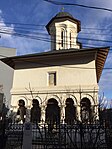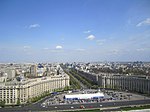State Jewish Theater (Romania)

Teatrul Evreiesc de Stat (TES, the State Jewish Theater) in Bucharest, Romania is a theater specializing in Jewish-related plays. It is the oldest Yiddish-language theater with uninterrupted activity in the world. Its contemporary repertoire includes plays by Jewish authors, plays on Jewish topics, and plays in Yiddish (which are performed with simultaneous translation into Romanian, using headphones installed in the theater in the 1970s). Many of the plays also feature Jewish actors. A precursor, the Teatru Evreiesc Baraşeum operated as a Jewish theater through most of World War II, although they were closed during the few months of the National Legionary State, and thereafter performed in Romanian rather than Yiddish through until the fall of Ion Antonescu.
Excerpt from the Wikipedia article State Jewish Theater (Romania) (License: CC BY-SA 3.0, Authors, Images).State Jewish Theater (Romania)
Strada Doctor Iuliu Barasch, Bucharest Centrul Civic (Sector 3)
Geographical coordinates (GPS) Address External links Nearby Places Show on map
Geographical coordinates (GPS)
| Latitude | Longitude |
|---|---|
| N 44.429391666667 ° | E 26.110522222222 ° |
Address
Teatrul Evreiesc de Stat (Teatrul Evreiesc Barașeum)
Strada Doctor Iuliu Barasch 15
030791 Bucharest, Centrul Civic (Sector 3)
Romania
Open on Google Maps











